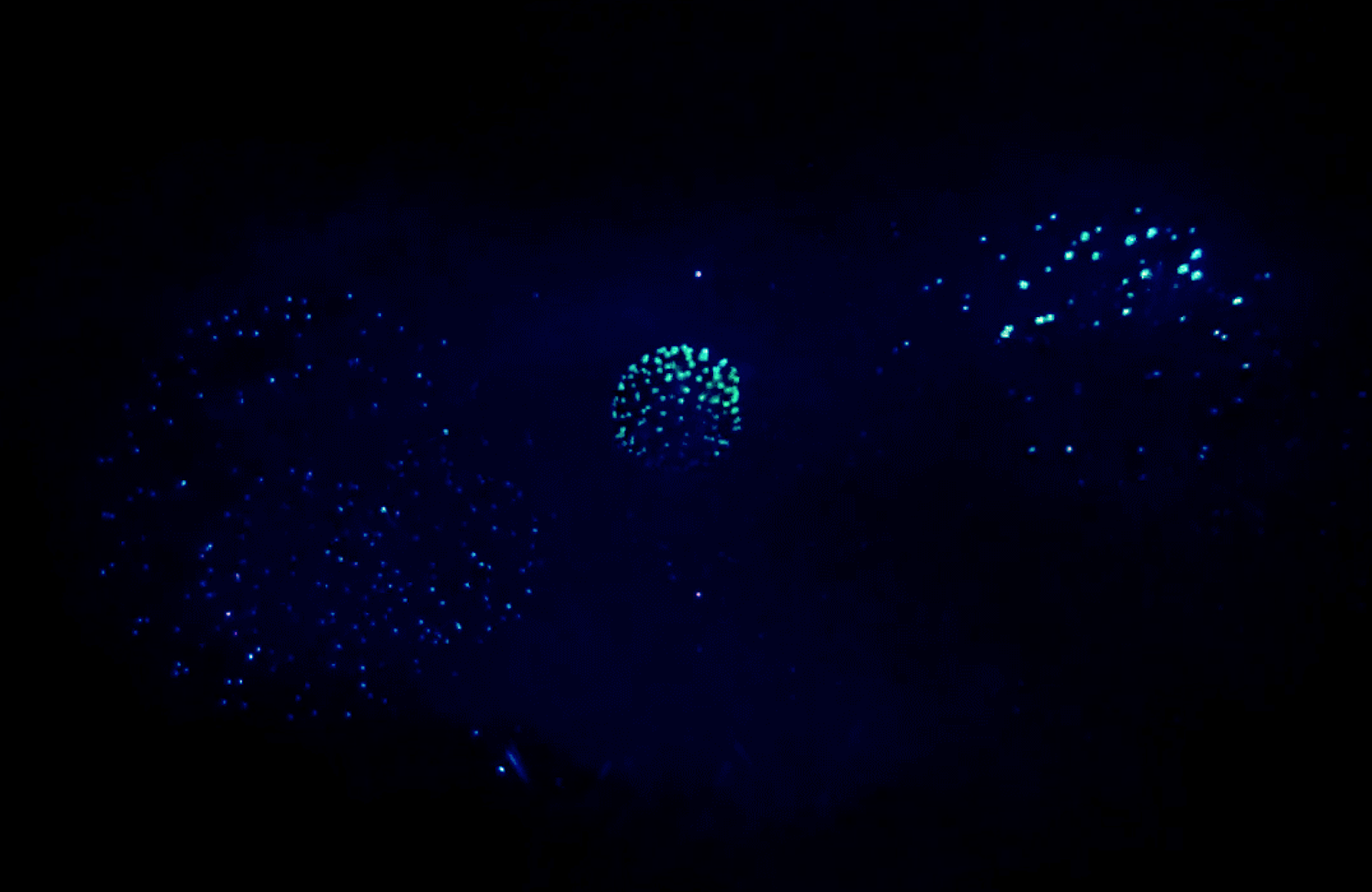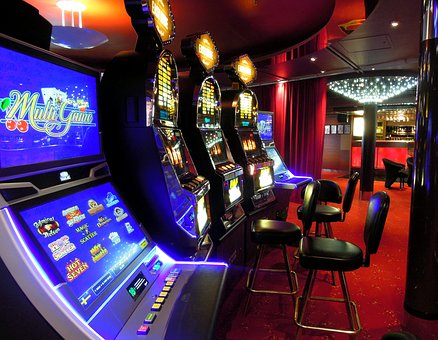Abstract
When you look at a firework sparkling in the night sky, you may wonder how this phenomenon occurs or how fireworks became a staple for special occasions. The creation of the modern firework underwent much experimentation to become the spectacle it is today. With gunpowder, fire, and “stars,” fireworks can range from sparklers to huge pyrotechnic shows. With slight changes to the design of the shell and what goes inside, fireworks can be used to paint a picture in the sky.
Introduction
Every year on the Fourth of July, millions of people come out to baseball fields and parks across the U.S. to see bursts of color and light coming from the firework display. Many events like the Fourth of July and New Year’s Eve would be incomplete without finishing off the night with a firework display. Although most people simply admire the beauty of the fireworks, much goes into each sparkle launched into the sky.
With testing, engineers and artists have improved firework technology to create phenomenal pyrotechnics. What started with a simple, yellow flash of light has turned into a phenomenon of spectacular light shows and colorful, precise firework displays that can be seen all over the world.
The First Firework
In 700 A.D. in China, the group who created what we know today as fireworks actually ended up stumbling on the invention without intending to do so[1]. It all started with alchemists who desired immortality. Experimenting with different substances, the group ended up mixing charcoal, sulfur, and saltpeter, which ended up becoming an early form of gunpowder [2]. They then decided to stuff the gunpowder into a bamboo stock and throw it into fire. When the bamboo hit the fire, the group witnessed a large explosion and heard a boom. They hoped to create a concoction that would give them eternal life but ended up with an explosive they called “firework.”
History
After the initial discovery of this firework, people adjusted its design and components to solve their own problems and make lighting them easier. For instance, tissue paper replaced bamboo to hold the firework together, which simplified the process since tissue paper is easier to attain. The addition of a fuse made it so fireworks could go off at a certain time instead of having to throw the whole concoction into a fire. By 900 A.D., the firework evolved into bombs and rockets. The Chinese began to use them in wars and would even stick them on arrows [1]. Around 1200 A.D., the idea of the firework traveled to Europe through explorers encouraging the Europeans to also incorporate firework-like weapons into their weaponry [1]. Fireworks gave people the ability to attack enemies at a longer distance.
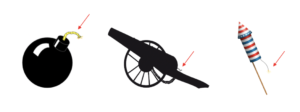
Figure 1. Objects that use fuses in order to cause a delayed explosion.
Although explosions are mostly associated with destruction, pyrotechnics realized that if launched high enough, these explosions could also paint a picture in the sky. Fireworks became a form of entertainment and were included to enhance celebrations. During Medieval Times, there was a group of pyrotechnics known as the “Green Men” whose sole job was to entertain guests by setting off fireworks [1]. The Green Men attained their nickname by wearing fresh leaves on their heads to protect themselves from firework sparks. Although the job may sound fun, it was deemed extremely dangerous as many died or had serious injuries due to the lack of safety protocols.
In Europe, rulers heard about fireworks and chose to use them as a way to make their celebrations more impressive. In 1486, Henry VII had a giant firework display after his wedding ceremony. About two hundred years later, the ability to create extraordinary firework show became highly esteemed as the fire master, James II, became a knight after his incredible display [1]. Fireworks became a symbol of extravagance, encouraging kings to use them to assert their wealth.
During the Renaissance period, people began to focus on improving the aesthetic design of fireworks and how to make them more impressive. Pyrotechnic schools opened up throughout Europe, most concentrated in Italy, where people solely focused on creating better fireworks. Students experimented by adding metals to fireworks, which turned into launching fireworks of different colors. Before these improvements, fireworks were simply booming flashes and a bit of light [1].
In the United States, fireworks date back to the first Independence Day in 1776. In a letter written to his wife, John Adams wrote, “I am apt to believe that [Independence Day] will be celebrated by succeeding generations as the great anniversary festival. It ought to be solemnized with pomp and parade… bonfires and illuminations [1].” Every year after this, fireworks continued to light the sky every Fourth of July.
Today, firework engineers continue to test the limits of fireworks. In 2016, a church in the Philippines called Iglesia Ni Cristo held the largest firework display to celebrate the new year. The firework show consisted of 810,904 fireworks and lasted 1 hour, 1 minute, and 32.25 seconds [3]. Making the show even more impressive, the whole display happened during a rain storm. In honor of the 2014 Japanese Katakai-Matsuri Festival in Honshu Japan, pyrotechnics launched the then largest aerial firework. The firework seen by the audience has a diameter of 850m which is about double the size of the Empire State Building (443.2m) [4]. The creators of the 1,015 lb. shell named the firework the “Yonshakudama,” and it is now launched every September [3]. Engineers had to build a shell large enough and with enough gunpowder to create a firework of that unprecedented size. Since 2014, fireworks in United Arab Emirates in honor of New Year’s Eve 2018 actually beat this world record with an even bigger shell weighing 2,397 lbs. [5]. Firework engineers today are continuing to create even more impressive fireworks and setting new world records.
Technical Description
A simple definition of a firework is a case filled with explosives that when ignited and launched explodes into the sky displaying a sparkly image of lights. The components of the firework consist of a casing, gunpowder, pods, and a fuse. Each part has an important role in the process.
Casing
The outer part of the firework holds everything together before the explosion and typically measures about 1 to 1.5 inches in diameter [6]. The casing is usually made out of paper or plastic and is often spherical or cylindrical in shape [7]. The shape of the casing does not affect the look of the firework but acts as a container for all the components. The differentiation of the casing comes with the price tag with the cylindrical paper shells being the least expensive while the cylindrical and plastic casing as the most expensive option.
Gunpowder
The gunpowder used in typical fireworks consists of a mixture of potassium nitrate, charcoal, and sulfur [8]. The charcoal acts as fuel, the potassium nitrate acts as an oxidizer, and the sulfur ensures a stable reaction [9]. When charcoal is mixed with oxygen, energy and carbon dioxide is formed which is the start of a fire. The oxidizing agent (potassium nitrate) helps speed up the process because without it, the reaction would be slow like that of a campfire. In order to create fire, there must be oxygen and the oxidizing agent provides the extra oxygen to create fire quickly. When there is a large amount of heat like the fire produced in the casing, gases expand. As gases expand, this causes the firework to launch, another function of the gunpowder.
Pods
The pods are the component in the firework that create the actual light and color of the firework, which is why they are often called “stars.” The pods are little spherical balls made out of paper or plastic filled with gunpowder. If coated with certain metal salts, the “star” will create a certain color in the sky [10]. For example, if a pyrotechnician wants to create an orange firework, they would know to use a particular type of calcium salt. The color and positioning of the pods will be discussed in more detail later in the article.
Fuse
The fuse is a string with gunpowder inside that helps the initial flame travel throughout the case. When the fuse is lit, the flame flows down the fuse, igniting the gunpowder inside the casing. It acts almost as an on switch beginning the process of the firework.
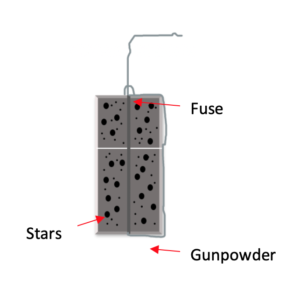
Figure 2. Basic firework with gunpowder, stars, and fuse.
The Explosion
Now comes the real magic, the actual explosion of the fireworks. The first step of the firework is the launch. In order for a large audience to see the firework, the firework must be launched high in the sky. The first step is to insert the shell into a mortar, which acts as a cannon and looks like a metal tube [11]. The mortar is then placed on top of black powder, which is called the lift charge. This black powder will actually launch the firework. Next, the pyrotechnician will place the fuse to the lift charge. The fuse is then lit and lights the black powder, which creates an explosion and the shell flies into the sky [11]. The heat and gas created by the explosion helps to launch the firework into the air [6]. The initial explosion of the lift charge also sets off the fuse in the shell of the firework, which is what will later make the shell explode and create the actual firework.
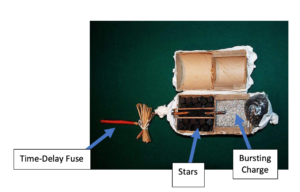
Figure 3. Open Firework [12].
Next, the firework must actually explode, which happens after the shell is launched. This process is completed by another fuse inside the shell called the time-delay fuse. Once the time delay fuse is set, the black powder and stars inside the shell are ignited, creating gas and heat. The shell then breaks open and stars go everywhere exploding in the sky. These stars are extremely hot and contain many gases that expand very quickly. The stars explode and create the light seen by the audience. The reason fireworks make a booming sound is because the gases expand faster than the speed of sound [6].
Artistic Aspects: Creating Shapes and Colors
Now that we know how fireworks work, let’s take a closer look at how fireworks can be engineered to explode in different shapes and colors. Depending on the arrangement of the stars, the firework can make certain shapes in the air. For example, you could place the stars in the formation of a star, heart, or even a smiley face and it will come out like this in the sky. Although in theory the shapes should be made perfectly in the sky every time, the way the stars explode is often unpredictable. It is difficult to measure exactly where the stars will go. Fireworks are often launched into the sky with the intent of making a certain shape, but the shape comes out warped.
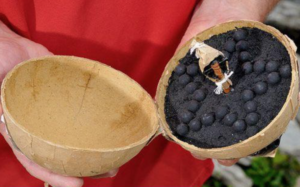
Figure 4. Star shaped firework star formation [12].
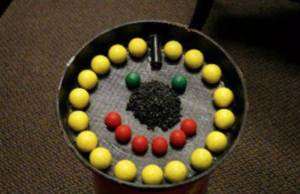
Figure 5. Smiley face firework star formation [12].
An easier aspect of a firework to control is the color. Fireworks vary in color through the use of specific metal salts. A few common salts used are strontium carbonate (red), sodium nitrate (yellow), copper chloride (blue), calcium chloride (orange), and barium chloride (green) [13]. The salts are placed inside the pod or can be a coating for the pod in order to create the color. If two metals are mixed inside the pod, this can also create a new color. For example, if you mix strontium carbonate and copper chloride, a purple firework would be produced. The metals and the colors they produce can be seen in the table below.
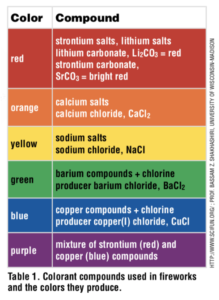
Figure 6. Compounds with the color each one produces [6].
Future of Fireworks
Today, firework technology continues to advance with many ideas for improving the field. For example, in response to noise complaints, noiseless fireworks have been considered for fireworks around the world. Every Independence Day, the police department receives an influx of calls over noise complaints [14]. In a few cities in Washington, the police department began strongly discouraging people from calling regarding firework noise complaints since it prohibits them from tending to more important calls [14]. In the Italian town of Collecchio, a law was approved that fireworks shows had to be silent [15]. Noiseless fireworks would also let theme parks put on more firework displays throughout the year. For residents who live near theme parks, they are constantly bombarded by the sounds of fireworks. People have reported their dogs going crazy and babies waking up after going to bed for the night. There have even been petitions to ban firework shows at certain parks [16]. Noiseless fireworks would let theme park visitors enjoy the show while giving neighbors peace and quiet.
Firework advances have also created entirely new industries, focusing on the design and showmanship of pyrotechnics. Firework designers are constantly experimenting with ways to enhance firework choreography, referring to the timed display of fireworks in accordance with beats of an accompanying song. Computer programming in this field has evolved to improve the timing and self-sufficiency of explosions. With this new technology, pyrotechnicians can keep a safer distance away from the fireworks and can create a synchronized fireworks show.
Conclusion
In the end, fireworks bring people together. Everyone gathers at special occasions and comes together to watch the firework show. Each pop of color and burst of light is perfectly engineered to go off at the right time and place. The beauty of the fireworks comes from the fact that their sole purpose is to make people happy. Sometimes all it takes is an accidental discovery and some engineering to bring light and joy.
References
[1] J. Cohen, “Fireworks’ Vibrant History”, HISTORY, 2018. [Online]. Available: https://www.history.com/news/fireworks-vibrant-history. [Accessed: 27- Apr- 2019].
[2] A. Bradford, “History of Fireworks”, Live Science, 2018. [Online]. Available: https://www.livescience.com/63468-fireworks-history.html. [Accessed: 27- Apr- 2019].
[3] R. Swatman, “Fireworks Night: Top 10 most explosive world records”, Guinness World Records, 2016. [Online]. Available: http://www.guinnessworldrecords.com/news/2016/11/fireworks-night-top-10-most-explosive-world-records-449882. [Accessed: 27- Apr- 2019].
[4] “Empire State Building – The Skyscraper Center”, Skyscrapercenter.com, 2019. [Online]. Available: http://www.skyscrapercenter.com/building/empire-state-building/261. [Accessed: 27- Apr- 2019].
[5] “Largest aerial firework shell”, Guinness World Records. [Online]. Available: http://www.guinnessworldrecords.com/world-records/largest-aerial-firework-shell. [Accessed: 27- Apr- 2019].
[6] K. De Antonis, “Fireworks!”, Acs.org, 2010. [Online]. Available: https://www.acs.org/content/dam/acsorg/education/resources/highschool/chemmatters/articlesbytopic/oxidationandreduction/chemmatters-oct2010-fireworks.pdf. [Accessed: 27- Apr- 2019].
[7] “Firework Shells – Plastic and Paper Shell Supplies”, Skylighter, Inc., 2019. [Online]. Available: https://www.skylighter.com/collections/shell-parts. [Accessed: 27- Apr- 2019].
[8] C. Woodford, “How fireworks work | Firework science”, Explain that Stuff, 2019. [Online]. Available: https://www.explainthatstuff.com/howfireworkswork.html. [Accessed: 27- Apr- 2019].
[9] A. Helmenstine, “Gunpowder Facts and History”, ThoughtCo, 2017. [Online]. Available: https://www.thoughtco.com/gunpowder-facts-and-history-607754. [Accessed: 27- Apr- 2019].
[10] A. Jeffries, “How do fireworks work?”, The Verge, 2013. [Online]. Available: https://www.theverge.com/2013/7/4/4489980/how-do-fireworks-work. [Accessed: 27- Apr- 2019].
[11] “How do fireworks work? (Everyday Mysteries: Fun Science Facts from the Library of Congress)”, Loc.gov, 2019. [Online]. Available: https://www.loc.gov/rr/scitech/mysteries/fireworks.html. [Accessed: 27- Apr- 2019].
[12] “Here’s How Different Kinds of Fireworks Work”, Popular Mechanics, 2018. [Online]. Available: https://www.popularmechanics.com/technology/g203/how-fireworks-work-photo-gallery/. [Accessed: 27- Apr- 2019].
[13] D. Conners, “How fireworks get their colors | EarthSky.org”, Earthsky.org, 2018. [Online]. Available: https://earthsky.org/human-world/how-do-fireworks-get-their-vibrant-colors. [Accessed: 27- Apr- 2019].
[14] T. Land, “Don’t call 911 for a firework noise complaint, some departments say”, K5 News, 2019. [Online]. Available: https://www.king5.com/article/news/local/dont-call-911-for-a-firework-noise-complaint-some-departments-say/281-570119275. [Accessed: 27- Apr- 2019].
[15] S. Yin, “‘Quiet Fireworks’ Promise Relief for Children and Animals”, Nytimes.com, 2016. [Online]. Available: https://www.nytimes.com/2016/07/01/science/july-4-fireworks-quiet.html. [Accessed: 27- Apr- 2019].
[16] N. Santana, “Santana: Disney Fireworks Impact on Neighborhood Health Needs Study”, Voice of OC, 2018. [Online]. Available: https://voiceofoc.org/2018/08/santana-disney-fireworks-impact-on-neighborhood-health-needs-study/. [Accessed: 27- Apr- 2019].
[17] J. Daley, “Four Explosive Advancements for Future Fireworks”, Smithsonian, 2016. [Online]. Available: https://www.smithsonianmag.com/smart-news/four-ways-fireworks-are-getting-even-better-180959680/. [Accessed: 27- Apr- 2019].

